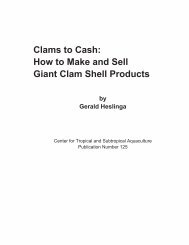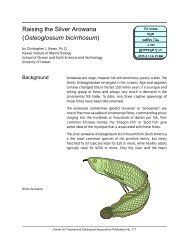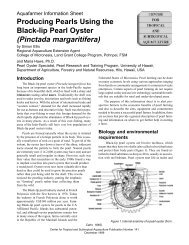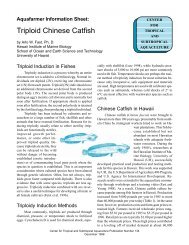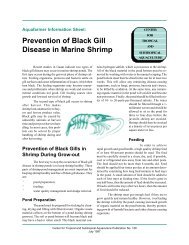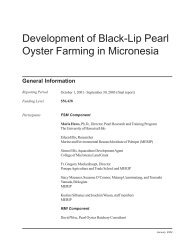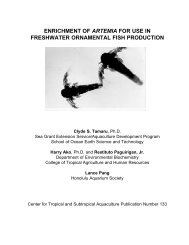The Basic Methods of Pearl Farming: A Layman's Manual - CTSA
The Basic Methods of Pearl Farming: A Layman's Manual - CTSA
The Basic Methods of Pearl Farming: A Layman's Manual - CTSA
Create successful ePaper yourself
Turn your PDF publications into a flip-book with our unique Google optimized e-Paper software.
<strong>Basic</strong> <strong>Methods</strong> <strong>of</strong> <strong>Pearl</strong> <strong>Farming</strong>ence from farmers who have worked with the technician before and be sure and write a service contractfor both you (the farmer) and technician to sign.Technicians can be good sources <strong>of</strong> technical advice.Each seeding technician has his own methods and it is imperative that you follow his instructionsduring the grafting process to guarantee success. Several months before the technician is scheduled toarrive, ask him for instructions on how to prepare the pearl oysters and farm for the grafting procedure.Try and learn as much as possible from the visiting technician about how to operate a farm. Even thebest technician cannot produce good pearls if farm management is poor before or after grafting.While many technicians also buy pearls, they may not <strong>of</strong>fer the best prices.Technicians will <strong>of</strong>ten make a farmer an <strong>of</strong>fer to buy the pearls immediately after a harvest. In manycases, the price <strong>of</strong>fered is below the market price, but you may feel pressured to accept the <strong>of</strong>fer eitherto please the technician or because you do not feel confident that you can sell the pearls elsewhere.Resist the temptation to sell the pearls immediately. You will usually be able to obtain a better pricefrom wholesaler pearl buyers or jewelers. If you want to sell to your technician, you should try to havethe pearls graded and the price set by an impartial pr<strong>of</strong>essional.<strong>The</strong> grafting processPreparation for grafting<strong>The</strong> ideal pearl oyster size for grafting is about 4.5-6 in (12-15 cm) in length, or aboutthe size <strong>of</strong> a woman’s hand.<strong>The</strong>se animals will be 1½-2 years <strong>of</strong> age. This age is ideal because the pearl oysters are still growingquickly and will produce nacre at a more rapid speed. <strong>The</strong> nacre produced by young pearl oysters alsotends to have more luster than that produced by older animals. Older and larger pearl oysters can begrafted, but are less likely to produce high-quality pearls.<strong>Pearl</strong> oysters gathered from the reef need special preparation for grafting.<strong>Pearl</strong> oysters collected as spat are superior to adults collected from the reef for pearl production. <strong>The</strong>reasons for this are not completely understood; it may be that animals farmed from a very young age aresimply more accustomed to the sometimes stressful conditions <strong>of</strong> a farm. Also, pearl oysters collectedfrom the reef are likely to be older. If you must use pearl oysters taken as adults from the reef, youshould prepare these carefully for grafting. <strong>The</strong>se animals should have been hung on lines or in basketsfor at least 6 months before seeding begins.Page 52



